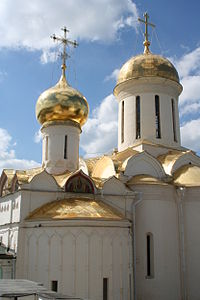This article has multiple issues. Please help improve it or discuss these issues on the talk page. (Learn how and when to remove these messages)
|
 The Trinity Cathedral of Troitse-Sergieva Lavra | |
| Primate | Patriarch Kirill I |
|---|---|
| Language | Church Slavonic (basic) and local languages |
| Headquarters | Moscow, Russia |
| Founder | Apostle Andrew, Vladimir of Kiev, Michael, 1st metropolitan of Kiev |
| Independence | 1448, de facto in the Metropolis of Moscow |
| Recognition | (as a patriarchate) in 1589 by Constantinople |
| Members | 125,000,000 |
| Official website | Russian Orthodox Church Department for External Church Relations official website |
| Part of a series on the |
| Eastern Orthodox Church |
|---|
| Overview |
The history of the Russian Orthodox Church is commonly traced back to the Metropolis of Kiev and all Rus', established upon the Conversion of Volodimer in c. 988 for ecclesiastical administration of Kievan Rus'. Several decades after the end of Kievan Rus' due to the Mongol invasion in 1237–1241, metropolitan Maximos of Kiev and all Rus' relocated to Vladimir on the Klyazma in Suzdalia in 1299, and his successor Peter moved to Moscow in 1325, while still keeping "of Kiev and all Rus'" in their titles.
As the Principality of Moscow rose in prominence, its princes sought autocephaly from the Ecumenical Patriarchate of Constantinople in the 15th century, which led to the unilateral establishment of the Metropolis of Moscow and all Rus' in 1448, and eventually to the 15th–16th century Moscow–Constantinople schism. In 1589, the metropolitan of Moscow was elevated to Patriarch of Moscow and all Rus', and recognised by the Ecumenical Patriarch Jeremias II of Constantinople for the first time, thereby consolidating the autocephalous ecclesiastical institution now known as the Russian Orthodox Church (although that name would not be official until the 20th century). Some time between 1685 and 1722, the annexation of the Metropolis of Kyiv by the Moscow Patriarchate happened, although the details and legality of this event are debated.[1]
The church reform of Peter the Great happened between 1700 and 1721, beginning the Synodal period that would last until the Russian Revolution of 1917. The early Bolsheviks repressed all institutionalised religions as superstitious oppression of the common people, but Joseph Stalin revived the Church in 1941 when faced with the German invasion. For the remainder of the Soviet Union's existence, the Russian Orthodox Church hierarchy and the Communist Party would collaborate and share power, while dissent was repressed. After the dissolution of the Soviet Union, the Church managed to regain much authority in Russian society, and in cooperation with president Vladimir Putin began promoting the imperialist idea of the Russian world (Russkiy mir) that should reunite to its former glory, especially towards Ukraine, although this contributed to the 2018 Moscow–Constantinople schism that have left the Eastern Orthodox churches around the world divided.[1]
- ^ a b Mykhaleyko, Andriy (25 February 2020). "The New Independent Orthodox Church in Ukraine". Südosteuropa. 67 (4). Walter de Gruyter GmbH: 476–499. doi:10.1515/soeu-2019-0037. ISSN 2364-933X.